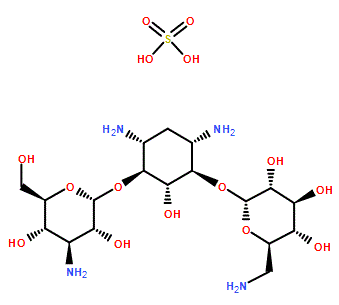Kanamycin sulfate, the sulfate salt of Kanamycin (Kanamycin A; Kantrex; Kanamycine), is an aminoglycoside bacteriocidal antibiotic effective against gram-positive and negative bacteria and mycoplasma. It has been used for the prevention and treatment of chicken pullorum, colibacillosis, enteritis and other diseases, and has a significant effect on systemic sepsis, respiratory tract infection, peritonitis, etc. caused by drug-resistant bacteria.Aminoglycosides like kanamycin irreversibly bind to specific 30S-subunit proteins and 16S rRNA. Specifically Kanamycin binds to four nucleotides of 16S rRNA and a single amino acid of protein S12.
Physicochemical Properties
| Molecular Formula | C18H38N4O15S |
| Molecular Weight | 582.575 |
| Exact Mass | 582.205 |
| Elemental Analysis | C, 37.11; H, 6.57; N, 9.62; O, 41.19; S, 5.50 |
| CAS # | 25389-94-0 |
| Related CAS # | Kanamycin;59-01-8 |
| PubChem CID | 441374 |
| Appearance | White to off-white solid powder |
| Density | 1.3619 (rough estimate) |
| Boiling Point | 809.5ºC at 760 mmHg |
| Melting Point | 250ºC |
| Flash Point | 443.4ºC |
| Index of Refraction | 117.5 ° (C=1, H2O) |
| Hydrogen Bond Donor Count | 13 |
| Hydrogen Bond Acceptor Count | 19 |
| Rotatable Bond Count | 6 |
| Heavy Atom Count | 38 |
| Complexity | 720 |
| Defined Atom Stereocenter Count | 15 |
| SMILES | S(=O)(=O)(O[H])O[H].O([C@]1([H])[C@@]([H])([C@]([H])([C@]([H])([C@@]([H])(C([H])([H])O[H])O1)O[H])N([H])[H])O[H])[C@@]1([H])[C@@]([H])(C([H])([H])[C@@]([H])([C@]([H])([C@@]1([H])O[H])O[C@]1([H])[C@]([H])([C@]([H])([C@@]([H])([C@@]([H])(C([H])([H])N([H])[H])O1)O[H])O[H])O[H])N([H])[H])N([H])[H] |
| InChi Key | OOYGSFOGFJDDHP-KMCOLRRFSA-N |
| InChi Code | InChI=1S/C18H36N4O11.H2O4S/c19-2-6-10(25)12(27)13(28)18(30-6)33-16-5(21)1-4(20)15(14(16)29)32-17-11(26)8(22)9(24)7(3-23)31-17;1-5(2,3)4/h4-18,23-29H,1-3,19-22H2;(H2,1,2,3,4)/t4-,5+,6-,7-,8+,9-,10-,11-,12+,13-,14-,15+,16-,17-,18-;/m1./s1 |
| Chemical Name | (2R,3S,4S,5R,6R)-2-(aminomethyl)-6-(((1R,2R,3S,4R,6S)-4,6-diamino-3-(((2S,3R,4S,5S,6R)-4-amino-3,5-dihydroxy-6-(hydroxymethyl)tetrahydro-2H-pyran-2-yl)oxy)-2-hydroxycyclohexyl)oxy)tetrahydro-2H-pyran-3,4,5-triol sulfate |
| Synonyms | Kanamycin sulfate; kanamycin A. Kanabristol; Kanacedin. |
| HS Tariff Code | 2941.90.1010 |
| Storage |
Powder-20°C 3 years 4°C 2 years In solvent -80°C 6 months -20°C 1 month Note: Please store this product in a sealed and protected environment, avoid exposure to moisture. |
| Shipping Condition | Room temperature (This product is stable at ambient temperature for a few days during ordinary shipping and time spent in Customs) |
Biological Activity
| ln Vitro | In vitro, different strains of mycobacteria show good antibacterial activity (MIC=1–5 μg/mL) when treated with kanamycin sulfate (0.1–100 μg/mL; 2 weeks)[1]. |
| ln Vivo |
In the lung and spleen of mice, kanamycin sulfate (2, 4 mg/kg; s.c.; once daily, six times a week for three weeks) inhibits the growth of bovine tubercle bacilli[1]. Kanamycin sulfate (1.25, 5 mg/kg; s.c.; single (at 3 h after infection)) increases the survival rate of mice while also inhibiting the growth of K. pneumonia DT-S in the lung, trachea, and blood of the mice in proportion to the dose administration[2]. |
| Cell Assay |
Cell Line: mycobacteria Ravenel, Kirchbergand, H37Rv, H2, and BCG. Concentration: 0.1-100 μg/mL Incubation Time: 2 weeks Result: demonstrated strong antibacterial activity against multiple mycobacterium strains (H37Rv, H2, H37RvR-PAS, Ravenel, and BCG), with MICs of 1 μg/mL and 5 μg/mL for the Kirchbergand strain, respectively. |
| Animal Protocol |
Animal Model: Model of infected bovine tubercle bacilli (Ravenel strain) in inbred strain normal mice (14–16 g)[1]. Dosage: 2, 4 mg/kg Administration: Subcutaneous injection; once daily, 6 times a week for 3 weeks. Result: demonstrated a notable impact on preventing the in vivo spread of tuberculosis, particularly in mouse lungs. |
| References |
[1]. Studies on kanamycin, a new antibiotic against tubercle bacilli. I. Effect on virulent tubercle bacilli in vitro and in mice. J Antibiot (Tokyo). 1957 Nov;10(6):233-5. [2]. Experimental respiratory tract infection with Klebsiella pneumoniae DT-S in mice: chemotherapy with kanamycin. Antimicrob Agents Chemother. 1980 Mar;17(3):494-505. [3]. Interaction of kanamycin and related antibiotics with the large subunit of ribosomes and the inhibition of translocation. Biochem Biophys Res Commun. 1978 Sep 29;84(2):358-65. [4]. Mechanism of inhibition of translocation by kanamycin and viomycin: a comparative study with fusidic acid. Biochem Biophys Res Commun. 1980 Jan 29;92(2):647-54. |
| Additional Infomation |
Kanamycin A sulfate is an aminoglycoside sulfate salt. It has a role as an antibacterial drug and a geroprotector. It contains a kanamycin A. Kanamycin Sulfate is the sulfate salt of kanamycin, a naturally occurring aminoglycoside antibiotic with antimicrobial property. Derived from Streptomyces kanamyceticus, kanamycin is an antibiotic complex consisting of three components: kanamycin A, the major component (also usually designated as kanamycin), and kanamycins B and C, the minor components. This agent irreversibly binds to the bacterial 30S ribosomal subunit. Specifically, this antibiotic is lodged between 16S rRNA and S12 protein within the 30S subunit. This leads to interference with translational initiation complex, misreading of mRNA, thereby hampering protein synthesis and resulting in bactericidal effect. Aminoglycosides are mostly ineffective against anaerobic bacteria, fungi and viruses. Kanamycin A Sulfate is the sulfate salt form of kanamycin A, the major component of the kanamycin complex, an aminoglycoside antibiotic isolated from Streptomyces kanamyceticus, with antibacterial activity. Antibiotic complex produced by Streptomyces kanamyceticus from Japanese soil. Comprises 3 components: kanamycin A, the major component, and kanamycins B and C, the minor components. See also: Kanamycin (annotation moved to). |
Solubility Data
| Solubility (In Vitro) |
H2O : ≥ 25 mg/mL (~42.91 mM) DMSO : < 1 mg/mL |
| Solubility (In Vivo) |
Solubility in Formulation 1: 50 mg/mL (85.83 mM) in PBS (add these co-solvents sequentially from left to right, and one by one), clear solution; with sonication. Solubility in Formulation 2: 50 mg/mL (85.83 mM) in Saline (add these co-solvents sequentially from left to right, and one by one), clear solution; with ultrasonication. Preparation of saline: Dissolve 0.9 g of sodium chloride in 100 mL ddH₂ O to obtain a clear solution. (Please use freshly prepared in vivo formulations for optimal results.) |
| Preparing Stock Solutions | 1 mg | 5 mg | 10 mg | |
| 1 mM | 1.7165 mL | 8.5825 mL | 17.1650 mL | |
| 5 mM | 0.3433 mL | 1.7165 mL | 3.4330 mL | |
| 10 mM | 0.1717 mL | 0.8583 mL | 1.7165 mL |
